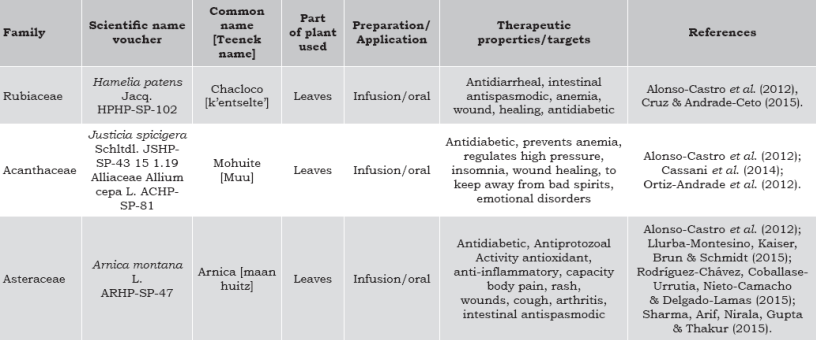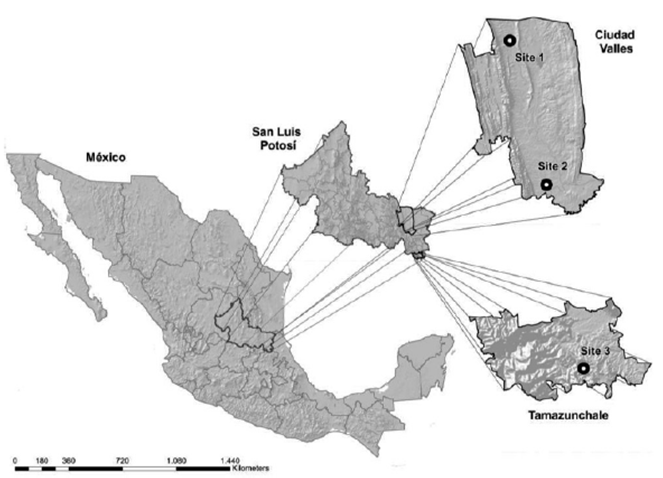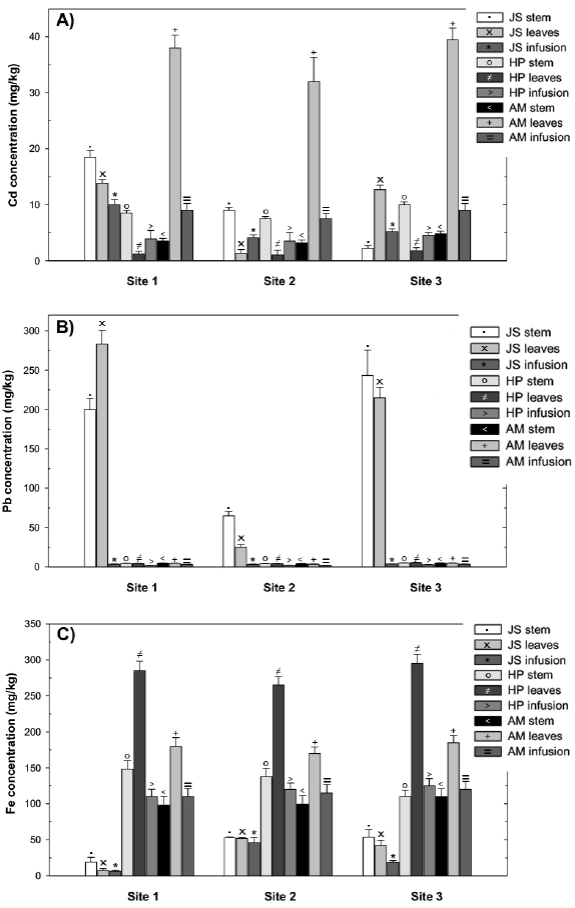Introduction
In the last two decades, use of herbal medicine has increased around the world, due to its putative efficiency, availability and general acceptability. Local flora is an important source of traditional medicines that are used for treatment of various diseases. For instance, 39 plant species belonging to 25 botanical families have been used for colon cancer treatment in Mexico with evidence in in vitro and in vivo studies (López-Rubalcava & Estrada-Camarena, 2016). In addition, 49 plants have been used in Mexican traditional medicine for treatment of disorders related to anxiety and depression (Jacobo-Herrera et al., 2016), and more than 100 medicinal plants have been used as immunostimulants (Alonso-Castro, Juárez-Vázquez & Campos-Xolalpa, 2016). In urban areas, vendors of herbal products, called “yerbateros”, obtain medicinal plants from the wild and perform their prescription to general population. Therefore, in order to guarantee herbal products safe use, their content of toxic elements such as cadmium (Cd) and lead (Pb) should be analyzed. The uptake of heavy metals by plant occurs via roots and foliage (deposition and adsorption) (Madaan, Mudgal, Mishra, Srivastava & Singh, 2011). Factors that influence accumulation and concentrations of toxic elements in a plant include: atmospheric depositions, bioavailability, nature of soil and water (pH and organic matter concentration), and site of collection. These factors along with harvesting and processing conditions (e.g., utensils containing Pb such as containers used for grinding) can affect heavy metals content in medicinal plants (Logan, Goins & Lindsay, 1997; Nwoko & Mgbeahuruike, 2011). The uptake of heavy metals by plants can increase certain toxic elements harmful potential that might enter into food chain. Accumulation of heavy metals in plant tissues disrupts many metabolic processes by alteration of oxidant-antioxidant balance and inhibition in activity and function of several enzymes (Rusyniak et al., 2010).
In Mexican traditional medicine, Justicia spicigera, Arnica montana and Hamelia patens are used for empirical treatment of several diseases (Alonso-Castro et al., 2012). A general description, as well as medicinal and economic importance of these plants are listed in table 1. In this study, these three medicinal plants were collected in the municipalities of Tamazunchale and Ciudad Valles, located in the Huasteca Potosina (Mexico) (figure 1), which is a region located in the coastal plain of the Gulf of Mexico. Some toxicological studies in terms of levels of heavy metals in water from rivers from the Huasteca Potosina have been carried out. For instance, Wong-Argüelles (2009) determined that levels of Cd and Pb in water from rivers of Huasteca Potosina, including rivers from the municipalities of Ciudad Valles and Tamazunchale (figure 1), were below than those allowed by Mexican Legislation for drinking water (NOM-127-SSA1-1994). However, Mejía-Saavedra & Díaz-Barriga (2008) reported that As levels in a river from the municipality of Tamazunchale were higher than those allowed by Mexican Legislation for drinking water. Mejía-Saavedra & Díaz-Barriga (2008) also showed that Cd, Pb, Hg, and As levels in sediments from the river in Tamazunchale were higher than those recommended by the Canadian Legislation for the protection of wildlife (Canadian Council of Ministers of the Environment [CCEM], 2000).
Table 1 General description and ethnopharmacological importance of medicinal plants used in the study.

Source: Author’s own elaboration.

Source: Figure prepared by Geog. Enrique Ibarra Zapata.
Figure 1 Map of study area, municipalities of Ciudad Valles and Tamazunchale, San Luis Potosí, México. Locations of the three sampling sites are shown.
General population perceives medicinal plants as safe and with no toxic effects because of their natural origin (Alonso-Castro et al., 2012). Content of contaminants in medicinal plants should be analyzed and regulated by health systems worldwide to help quality assessment of these products. Poisonings associated with presence of toxic metals in medicinal plants have been reported in some countries (Dunbabin, Tallis, Popplewell & Lee, 1992; Kákosy, Hudák & Náray, 1996; Markowitz et al., 1994; Sadhu et al., 2015). Therefore, it is necessary to perform studies regarding content of heavy metals in medicinal plants used in Mexican traditional medicine. Nevertheless, in Mexico there is limited information in terms of toxic elements content in medicinal plants. The objective of this study was to collect three medicinal plants (Justicia spicigera, Arnica montana y Hamelia pantens) from two municipalities in the Huasteca Potosina region and analyze their Pb, Cd and Fe content.
Materials and methods
Whole plants of J. spicigera, A. montana and H. patens (n = 3), with a height of approximately 0.9 m to 1.0 m, were collected at three different sites in the Huasteca Potosina (table 2 and figure 2). The three plants were washed with tap water and then with deionized water to remove any adhering dust particles.
Table 2 List of diverse locations in Huasteca Potosina, Mexico from where medicinal plants were collected.

Source: Author’s own elaboration.

Source: Author’s own elaboration.
Figure 2 Mean (n = 3) concentrations of heavy metals in leaves, stem and infusion of medicinal plants Justicia spicigera, Hamelia patens and Arnica montana collected from three different sites of Huasteca Potosina, México. A) Cd concentration (mg/kg); B) Pb concentration (mg/kg); C) Fe concentration (mg/kg). Error bars represent standard error of concentrations.
Plant material was sectioned into stem and leaves, dried at 70 °C during 1 h, and grounded in a Wiley mill for 2 min. Additionally, infusions of J. spicigera, H. patens and A. montana were prepared, each, by adding 1 g of aerial parts into 1 l of boiling distilled water. Plant material was boiled for 5 min and cooled to room temperature for 10 min. This procedure was carried out according to traditional way infusion preparation of medicinal plants in the Huasteca Potosina (Alonso Castro et al., 2012). All samples were preserved in High-density polyethylene (HPDE) bottles at room temperature and protected from light and dust. Analyses of Cd, Pb and Fe were carried out by acid digestion with 0.1 mL HNO3 (reactive grade, Fermont) per 2 mg of plant material during 4 days. Acid digestion was performed at room temperature in closed Teflon vessels. In order to complete organic matter oxidation, acid digestion was continued during 24 h by adding 0.5 mL of H2O2 30% (v/v) (Alfaro-De La Torre, 1997; Yan, Mackie & Dillon, 1990). After evaporating remaining acid, samples were allowed to dry at room temperature, and residue was re-dissolved with HNO3 5% (v/v) to complete 25 mL (Loring & Rantala 1992).
Reference plant material Lagaroshipon major (Community Bureau of Reference [CBR], Reference material No. 60) and blanks were analyzed in triplicate to determine accuracy of determinations. Recovery rate for reference plant sample ranged between 90% and 110%.
Content of Cd, Pb, and Fe in plant material was determined using an atomic absorption spectrophotometer (AAS) using an air-acetylene flame or graphite furnace (Varian-SpectrAA 220 FS, Palo Alto, CA). Detection limits for analytical methods were: 0.01 mg/Kg, 0.01 mg/Kg, 0.03 mg/Kg, for Cd, Pb and Fe respectively. A certified water sample for trace elements (TM-DWS, National Water Research, and Canada) was run with samples analyzed by AAS employing a graphite furnace to ensure an optimum quality control during analytical procedures. Recovery rate for certified water sample ranged between 100% ± 15%.
Mean of metal concentrations in plant material is reported in mg/Kg based on dry weight. Differences between sampling sites with respect to mean concentrations of heavy metals in stem and/or leaves were evaluated by using a one-way analysis of variance (ANOVA) test at significance level of 95%. Results were considered significantly different where the calculated P-values were ≤ 0.05. All calculations were done employing the Graph Instat TM V2.02 program.
Results
Concentrations of Cd, Pb and Fe in raw material and their infusions are shown in figure 2. Findings indicated that the highest Cd concentration was found in leaves from A. montana collected in sites 1 (38 mg/kg ± 2.3 mg/kg) and 3 (39.5 mg/kg ± 2.1 mg/kg), whereas the lowest Cd concentration was found in H. patens leaves collected in site 2 (0.2 mg/kg ± 0.01 mg/kg) (figure 2A). Safe limit for Cd is 0.3 mg/kg in plant material final dosage (World Health Organization [WHO], 1999). Taking this into account, the following preparations can be considered as safe: leaves and infusion of H. patens and A. montana, each from the 3 sites of collection, J. spicigera infusion from sites 2 and 3, J. spicigera leaves from site 2, and J. spicigera stem from site 3. In contrast, concentration of Pb in all medicinal plants ranged from 283.3 mg/kg (J. spicigera leaves from site 1) to 2.1 mg/kg (A. montana infusion from site 2) (figure 2B). Permissible limit for Pb is 10 mg/ kg set by the WHO (1999). Considering this value, only J. spicigera leaves and stem, from all 3 sites of collection could not be considered as safe for human because it exceeds permissible limits of heavy metals in herbal products (Food and Agriculture Organization [FAO] / World Health Organization [WHO], 1984; WHO, 1998, 2004, 2007, 2011; Zhang 1998). Pb and Cd are toxic pollutants that affect human health (Khan et al., 2014). Pb can cause anemia, neurological disorders, hyperactivity, among others (Marsden, 2003), whereas Cd affects lungs, reproductive system, kidneys, and bones (Godt et al., 2006). In this study, concentrations of Pb in J. spicigera were higher than those found in medicinal plants from Ethiopia and Pakistan (Baye & Hymete, 2010; Nawab et al., 2015). In addition, concentrations of Pb and Cd in the three medicinal plants were higher than those reported by Sadhu et al. (2015) in medicinal plants collected from India. Iron (Fe) is an essential element for plants and humans. However, a chronic excessive ingestion of Fe induces hypovolemic shock and liver failure (Lee & Lee, 2002; Mudgal, Madaan, Mudgal, Singh & Mishra, 2010; Yi & Guerinot, 1996). Concentrations of Fe found in this study ranged from 6.3 mg/kg (J. spicigera infusion at site 1) to 295 mg/kg (H. patens leaves at site 3) (figure 2C). It is considered that content of Fe in plant tissue ranges from 50 mg/kg - 300 mg/kg (in terms of dry weight). Results suggest that these three medicinal plants contain an adequate concentration of Fe, which corroborates the empirical use of J. spicigera and H. patens, each, for empirical treatment of anemia (Alonso-Castro et al., 2012). Nevertheless, it has been reported that plants exposed to Cd contamination decreases their uptake of Fe (Baryla et al., 2001; Sikka & Nayyar, 2012). In this study, content of Cd found in medicinal plants did not alter their concentration of Fe.
It is probable that consuming herbal drugs obtained from polluted sources will lead to serious health hazards, especially if this results in exposure to Cd and Pb (Mishra, Dwivedi & Singh, 2010).
Discussion
Heavy metals are natural occurring elements in the biosphere. Because of anthropogenic activities, many of these elements have been released in the environment and their concentrations have increased (Alloway, 1995). Worldwide, many areas used for agricultural purposes are contaminated with heavy metals (Nagajyoti, Lee & Sreekanth, 2010; Neilson & Rajakaruna, 2015). Plants can uptake toxic metals from the soil, water or air. Heavy metals may enter into food chain through ruminants, such as cattle, sheep, and goats, which are fed with plants (Oskarsson, Jorhem, Sundberg, Nilsson & Albanus, 1992; Waqas et al., 2015). Human beings might be intoxicated with heavy metals by direct consumption of medicinal plants contaminated with these elements. Therefore, it is necessary to estimate presence of toxic elements such as Cd and Pb in medicinal plants in order to provide their safe use. Heavy metal concentrations were determined in raw material (stem and leaves) and in infusions of aerial parts of J. spicigera, A. montana and H. pantens because these are plant parts and a way of administration commonly used in Mexican traditional medicine.
Accumulation of heavy metals in the three medicinal plants tend to vary depending on site of collection and on the medicinal plant. The highest concentrations of Cd were found in site A, whereas the highest concentrations of Pb were found in sites A and B. Some plants have developed mechanisms to grow in contaminated sites with heavy metals such as Cd and Pb (Khan et al., 2015). In Fe case, there was not found a clear pattern of maximum accumulation among studied sites. Results also indicated the lowest accumulation of heavy metals in medicinal plants was found in site 2. Variations regarding accumulation of heavy metals in medicinal plants may be due to some factors such as mineral composition of soil, total concentration of dissolved heavy metals in each sampling site, predominant dissolved chemical species, and mechanisms of mobilization at sediment-water interface of heavy metals. Also, transfer coefficients of metals affect heavy metal accumulation in plants (Sadhu et al., 2015). For instance, Pb has low transfer coefficients, remains stably bound to soil structures, and shows minimum bioavailability to plants. In contrast, metals like Cd have higher transfer coefficients and are easily taken up by plants (Kloke, Sauerbeck & Vetter, 1984).
Parameters described above are also influenced by release of chelating agents by plants as well as physicochemical and biological variations such as temperature, cation exchange capacity, nature of contaminants, salinity, sediment depth, redox potential, water and sediment pH, organic matter content, microbial biota, and physiological characteristics of each medicinal plant (Gregor, 2004).
Conclusion
In summary, this study indicates that detection of toxic elements, such as Cd and Pb, in medicinal plants is highly relevant for their quality control assessment. Therefore, medicinal plants should be monitored regarding place where they are collected. Also, it is necessary to implement policies in order to identify in marketplaces, herbs which contain contaminants, such as toxic metals, which represent a threat for human health. Thus, collection of medicinal plants should be done in monitored sites which are free of contamination. This study also gives information for conducting other studies in different parts of Mexico for quantification of toxic metals in medicinal plants.











 nueva página del texto (beta)
nueva página del texto (beta)


